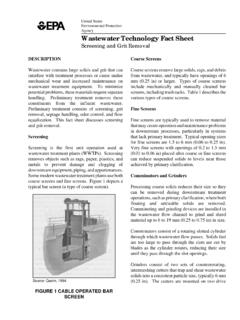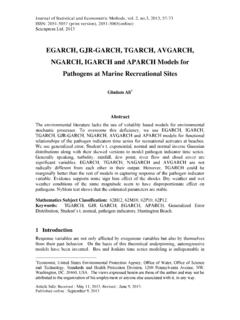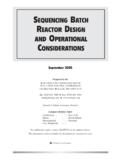Transcription of Wastewater Technology Fact Sheet: In-Plant Pump Stations
1 united states Office of Water EPA 832-F-00-069. environmental protection Washington, September 2000. agency Wastewater Technology Fact Sheet In-Plant Pump Stations DESCRIPTION. TABLE 1 PUMP APPLICATION. The terrain of the treatment plant site and the Pump Type Typical influent sanitary sewer depth govern the need for Application and location of In-Plant pumping facilities. In-Plant Centrifugal Raw Wastewater Flush Water pump Stations are facilities that consist of pumps Primary Sludge Spray Water and service equipment designed to pump flows from lower to higher elevations to allow continuous Secondary Sludge Seal Water and cost-effective treatment through unit processes Effluent Wastewater within the plant. Positive Primary Sludge Displacement The type of pumps most commonly used at Wastewater treatment plants include the centrifugal, Thickened Sludge progressive cavity, and positive displacement. The Digested Sludge three types are listed in Table 1 with the different Slurries pump applications.
2 Archimedes screw pumps (progressive cavity) are used to pump raw Chemical Feed Applications Wastewater and return activated sludge in treatment plants, but only in larger facilities because of the Progressive All types of Sludge Cavity high purchase cost. These pumps are popular because they are relatively easy to operate. All types of Slurries Source: WEF, 1992 and Sanks, 1992. The focus of this section will be on centrifugal pumps for raw Wastewater and effluent pumping Stations include at least two constant-speed pumps applications. ranging in size from 38 to 75,660 lpm (10 to 20,000 gpm) each and have a basic wet-well level Key elements of every pump station include: wet control system to sequence the pumps during well, pumps, piping with associated valves and normal operation. strainers, motors, power supply system, equipment control and alarm system, odor control system and The most common method for pump control uses ventilation system.
3 Pump station equipment and liquid level controls that indicate when a desirable systems are often installed in an enclosed structure. water level is attained in the wet well. A trapped Pump Stations can be constructed on site (custom- air column, or bubbler system that senses pressure designed) or pre-fabricated in a factory. Pump and level, is commonly used for pump station station capacities range from 76 lpm (20 gpm) to control. Other control alternatives are electrodes more than 378,500 lpm (100,000 gpm). Pre- placed at cut-off levels, and float switches. A more fabricated pump Stations generally have capacity of sophisticated control operation involves the use of up to 38,000 lpm (10,000 gpm). Usually, pump variable speed drives. Buildings, although not necessary for the operation blend-in with the surrounding environment in of the pumps, are required if service and repair residential areas. They require less space and work have to be carried out on-site, to protect typically are easier and less expensive to construct electrical equipment from weather, and to provide for Wastewater flow capacities of 38,000 lpm room for personnel (sometimes in response to local (10,000 gpm) or less.)
4 Figures 1 and 2 illustrate the regulations). Isolation valves are used to close off two types of pumps. the pumping station or parts of it for routine Hoist inspection and maintenance and repair of the Discharge structure. For large pump Stations , the wet wells are divided to allow for future repair or rehabilitation while the pump station continues to Wet Well operate. Large sloping fillets or wet-well mixers Dry Well are used to minimize solids deposition in the wet wells. Designs for self-cleaning wet wells are becoming more prominent. Pump Stations are typically provided with equipment for pump removal. Floor doors or openings above the pump room and an overhead monorail beam, bridge crane, Inlet or portable hoist are commonly used. Common Modifications Source: Qasim, 1994. FIGURE 1 DRY-WELL PUMP. The two most commonly used types of pump Stations are the dry-pit or dry-well and submersible Based on the type of construction, two types of pump Stations .
5 In dry-well pump Stations the pump Stations are most common: custom-designed pumps and valves are housed in a pump room (dry and pre-fabricated (factory-built) pump Stations . pit or dry-well), that can be easily accessed. The Custom-designed Stations are widely used for large wet well is a separate isolated chamber attached or flow applications (22,700 lpm or 6,000 gpm and located adjacent to the dry-well (pump room) above) because they can be designed to structure. accommodate practically any set of flows, heads, footprint, and special features. In addition, The submersible pump Stations do not have a Hoist separate pump room, however, the pump station header piping, associated valves, and flow meters are located in a separate dry vault on the surface for D ischarge easy access. Submersible pump Stations include sealed pumps that operate submerged in the wet well. These submerged pumps are not intended for frequent inspection, but can be removed periodically to the surface and re-installed using guide rails and a hoist.
6 Key advantages of the dry- well pump Stations are that they allow an easy access for routine visual inspection and maintenance, and in general they are easier to repair than submersible pumps. Key advantages of the submersible pump station include lower costs than the dry-well Stations and an ability to operate Source: Qasim, 1994. without frequent pump maintenance. In addition, submersible pump Stations usually do not require large aboveground structures and are easier to FIGURE 2 WET-WELL PUMP. custom-designed pump Stations are typically more pumping can reduce the size and cost of the wet spacious and accessible, and have a longer well and allows the pumps to operate at maximum structural life than factory-built pump Stations . efficiency under a variety of flow conditions. Because variable-speed pumping allows pump Pre-fabricated pump Stations are available in station discharge to match inflow, only a nominal various forms and can be either dry-well or wet-well storage volume is required and the well submersible.
7 Pre-fabricated pump Stations are water level is maintained at a near constant typically used for smaller flows because they are elevation. Variable-speed pumping may allow a more compact and generally lower in cost than given flow range to be achieved with fewer pumps custom-designed pump Stations . Pre-fabricated dry- than would a constant-speed alternative. Variable- well pump Stations usually include steel or plastic speed Stations also minimize the number of pump shell that is designed to house one to three vertical- starts and stops, reducing mechanical wear. shaft flooded suction pumps. Pumps, valves and Although there is a significant energy saving other equipment are installed at the factory prior to potential for Stations with large friction losses, it shipment. Circular station shells are more common may not justify the additional capital costs unless and larger pump Stations can have an oval shape. the cost of power is relatively high.
8 The variable Pump station shells are typically bolted to cast-in- speed equipment also requires more room within place concrete base slabs at the job site. In wet- the pump station and may produce more noise and well configurations, the wet well usually is heat than constant speed pumps. constructed of pre-cast concrete. Pre-fabricated submersible Stations are typically constructed of Modern pump Stations are equipped with automatic pre-cast concrete or steel and can accommodate one controls for pump starting and operational or two submersible pumps. For pre-cast concrete sequencing. The pump Stations typically have Stations , the pump manufacturer may provide a standby pumps to increase reliability and provide complete package of equipment, including adequate capacity for unusually high flows. In submersible pumps, discharge elbows, check unattended pumping Stations , automatic controllers valves, access hatches, and level controls.
9 For steel are frequently used to allow switch over to standby Stations , the equipment is typically pre-packaged at units when a pump fails. Flow recording equipment the factory. Fiberglass tanks are typically used for is often installed to record instantaneous pumping smaller pump Stations . rates and the total flow pumped. APPLICABILITY ADVANTAGES AND DISADVANTAGES. In-Plant pump Stations are used to move Wastewater Limitations from lower to higher elevation, particularly where the elevation of the source is not sufficient for Compared with gravity conveyance, pump Stations gravity flow and/or the use of gravity conveyance require an outside source of power. If the power will result in excessive excavation depths and high supply is interrupted, flow conveyance is plant construction costs. In-Plant pump Stations are discontinued. Unless there are overflow structures, used to pump flow from areas too low to drain by discontinuation of pump station operation can result gravity into nearby sewer lines.
10 In flooding the area upstream of the pump station and can interrupt the normal operations of the Current Status treatment facilities. This limitation is typically handled by providing a stand by power source ( , Variable speed pumping is often used to optimize back-up generator). pump performance and minimize power use. Several types of variable-speed pumping equipment The useful life of pump station equipment is are available, including variable voltage and typically limited to 20 to 30 years, with good frequency drives, eddy current couplings, and maintenance. Pump station structures typically mechanical variable-speed drives. Variable-speed have a useful life of 50 years. The useful life of pump station equipment and structures can be Advantages prolonged by using corrosion-resistant materials and protective coatings. Use of In-Plant pump Stations can reduce the depth of plant structures. For example, consider a Reliability treatment plant located on uniform ground elevation.













